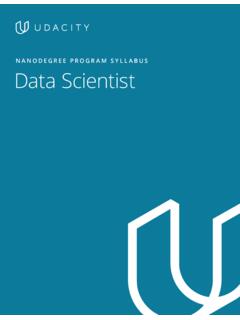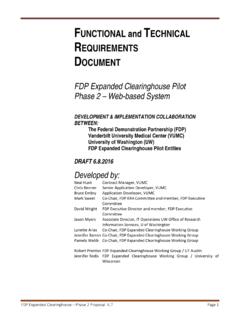Transcription of Laravel - Tutorialspoint
1 Laravel Laravel About the Tutorial Laravel is a powerful MVC PHP framework, designed for developers who need a simple and elegant toolkit to create full-featured web applications. Laravel was created by Taylor Otwell. This is a brief tutorial that explains the basics of Laravel framework. Audience This tutorial will guide the developers and students who want to learn how to develop a website using Laravel . This tutorial is particularly meant for all those developers who have no prior experience of using Laravel . Prerequisites Before you start proceeding with this tutorial, we make an assumption that you are familiar with HTML, Core PHP, and Advance PHP. We have used Laravel version in all the examples. Copyright & Disclaimer Copyright 2016 by Tutorials Point (I) Pvt. Ltd. All the content and graphics published in this e-book are the property of Tutorials Point (I). Pvt. Ltd. The user of this e-book is prohibited to reuse, retain, copy, distribute or republish any contents or a part of contents of this e-book in any manner without written consent of the publisher.
2 We strive to update the contents of our website and tutorials as timely and as precisely as possible, however, the contents may contain inaccuracies or errors. Tutorials Point (I) Pvt. Ltd. provides no guarantee regarding the accuracy, timeliness or completeness of our website or its contents including this tutorial. If you discover any errors on our website or in this tutorial, please notify us at i Laravel Table of Contents About the Tutorial .. i Audience .. i Prerequisites .. i Copyright & i Table of Contents .. ii 1. Laravel OVERVIEW .. 1. Introduction .. 1. Laravel Features .. 1. 2. Laravel 2. 3. Laravel APPLICATION 4. Root Directory .. 4. App Directory .. 5. 4. Laravel CONFIGURATION .. 6. Basic Configuration .. 6. Environmental Configuration .. 6. Database 7. Naming the 8. Maintenance Mode .. 8. 5. Laravel ROUTING .. 10. Basic 10. Routing Parameters .. 13. 6. Laravel MIDDLEWARE .. 16. Define Middleware .. 16. Register Middleware .. 17. ii Laravel Middleware 19. Terminable Middleware.
3 22. 7. Laravel 27. Basic Controllers .. 27. Controller Middleware .. 28. Restful Resource Controllers .. 33. Implicit Controllers .. 35. Constructor Injection .. 38. Method Injection .. 39. 8. Laravel REQUEST .. 41. Retrieving the Request URI .. 41. Retrieving Input .. 43. 9. Laravel COOKIE .. 47. Creating Cookie .. 47. Retrieving Cookie .. 47. 10. Laravel RESPONSE .. 51. Basic Response .. 51. Attaching Headers .. 51. Attaching Cookies .. 52. JSON Response .. 53. 11. Laravel VIEWS .. 54. Understanding Views .. 54. Passing Data to Views .. 55. Sharing Data with all Views .. 55. Blade 57. iii Laravel 12. Laravel 61. Redirecting to Named 61. Redirecting to Controller Actions .. 62. 13. Laravel WORKING WITH 64. Connecting to Database .. 64. Insert Records .. 64. Retrieve Records .. 67. Update Records .. 70. Delete Records .. 74. 14. Laravel ERRORS AND LOGGING .. 78. Errors .. 78. Logging .. 78. 15. Laravel FORMS .. 79. 16. Laravel LOCALIZATION .. 85. 17. Laravel SESSION .. 89. Accessing Session Data.
4 89. Storing Session Data .. 89. Deleting Session Data .. 89. 18. Laravel VALIDATION .. 93. 19. Laravel FILE UPLOADING .. 98. 20. Laravel SENDING EMAIL .. 102. 21. Laravel AJAX .. 108. 22. Laravel ERROR 111. HTTP Exceptions .. 111. iv Laravel Custom Error pages .. 111. 23. Laravel EVENT HANDLING .. 114. 24. Laravel FACADES .. 122. 25. Laravel SECURITY .. 128. v 1. Laravel Overview Laravel Introduction Laravel is an MVC framework with bundles, migrations, and Artisan CLI. Laravel offers a robust set of tools and an application architecture that incorporates many of the best features of frameworks like CodeIgniter, Yii, MVC, Ruby on Rails, Sinatra, and others. Laravel is an Open Source framework. It has a very rich set of features which will boost the speed of Web Development. If you familiar with Core PHP and Advanced PHP, Laravel will make your task easier. It will save a lot time if you are planning to develop a website from scratch. Not only that, the website built in Laravel is also secure.
5 It prevents the various attacks that can take place on websites. Laravel Features Laravel offers the following key features: Modularity Testability Routing Configuration management Query builder and ORM (Object Relational Mapper). Schema builder, migrations, and seeding Template engine E-mailing Authentication Redis Queues Event and command bus 6. 2. Laravel Installation Laravel For managing dependencies, Laravel uses composer. Make sure you have a Composer installed on your system before you install Laravel . Step 1: Visit the following URL and download composer to install it on your system. Step 2: After the Composer is installed, check the installation by typing the Composer command in the command prompt as shown in the following screenshot. Step 3: Create a new directory anywhere in your system for your new Laravel project. After that, move to path where you have created the new directory and type the following command there to install Laravel . composer create-project Laravel / Laravel prefer-dist Step 4: The above command will install Laravel in the current directory.
6 Start the Laravel service by executing the following command. php artisan serve 7. Laravel Step 5: After executing the above command, you will see a screen as shown below: Step 6: Copy the URL underlined in gray in the above screenshot and open that URL in the browser. If you see the following screen, it implies Laravel has been installed successfully. 8. 3. Laravel Application Structure Laravel Root Directory The root directory of Laravel contains various folders and files as shown in the following figure. app: This directory contains the core code of the application. bootstrap: This directory contains the application bootstrapping script. config: This directory contains configuration files of application. database: This folder contains your database migration and seeds. public: This is the application's document root. It starts the Laravel application. It also contains the assets of the application like JavaScript, CSS, Images, etc. 9. Laravel resources: This directory contains raw assets such as the LESS & Sass files, localization and language files, and Templates that are rendered as HTML.
7 Storage: This directory contains App storage, like file uploads etc. Framework storage (cache), and application-generated logs. test: This directory contains various test cases. vendor: This directory contains composer dependencies. App Directory This is the application directory. It contains a variety of additional directories, which are described below: Console: All the artisan commands are stored in this directory. Events: This directory stores events that your application can raise. Events may be used to alert other parts of your application that a given action has occurred, providing a great deal of flexibility and decoupling. Exceptions: This directory contains your application's exception handler and is also a good place to stick any exceptions thrown by your application. Http: This directory contains your controllers, filters, and requests. Jobs: This directory contains the queueable jobs for your application. Listeners: This directory contains the handler classes for your events.
8 Handlers receive an event and perform logic in response to the event being fired. For example, a UserRegistered event might be handled by a SendWelcomeEmail listener. Policies: This directory contains various policies of the application. Providers: This directory contains various service providers. 10. 4. Laravel Configuration Laravel The config directory, as the name implies, contains all of your application's configuration files. In this directory, you will find various files needed to configure database, session, mail, application, services etc. Basic Configuration After installing Laravel , the first thing we need to do is to set the write permission for the directory storage and bootstrap/cache. Generate Application key to secure session and other encrypted data. If the root directory doesn't contain the .env file then rename the . to .env file and execute the following command where you have installed Laravel . The newly generated key can be seen in the .env file. You can also configure the locale, time zone, etc.
9 Of the application in the file. Environmental Configuration Laravel provides facility to run your application in different environment like testing, production etc. You can configure the environment of your application in the .env file of the root directory of your application. If you have installed Laravel using composer, this file will automatically be created. 11. Laravel In case you haven't installed Laravel , you can simply rename the . file to .env file. A sample of file is shown below. Notice the text underlined gray in the above image. Local environment variable has been set. It can further be changed to production or testing as per your requirement. Database Configuration The database of your application can be configured from file. You can set configuration parameters that can be used by different databases and you can also set the default one to use. 12. Laravel Naming the Application The App Directory, by default, is namespaced under App. To rename it, you can execute the following command and rename the namespace.
10 Php artisan app:name <name-of-your-application>. Replace the <name-of-your-application> with the new name of your application that you want to give. Maintenance Mode We need to modify our website on a regular basis. The website needs to be put on maintenance mode for this. Laravel has made this job easier. There are two artisan commands which are used to start and stop the maintenance mode which are described below. Start Maintenance Mode To start the maintenance mode, simply execute the following command. php artisan down After successful execution, you will receive the following output: 13. Laravel It will activate the Maintenance mode and all the request to server will be redirected to a single maintenance page as shown in the following screenshot. Stop Maintenance Mode After making changes to your website and to start it again, execute the following command. php artisan up After successful execution, you will receive the following output: 14. Laravel 15. 5. Laravel Routing Laravel Basic Routing Basic routing is meant to route your request to an appropriate controller.












